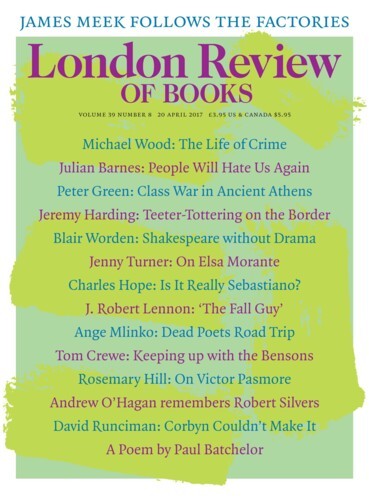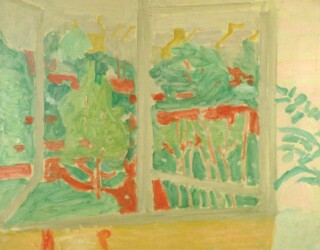According to Herbert Read, ‘the most revolutionary event in post-war British art’ was Victor Pasmore’s conversion from figurative to abstract painting. Victor Pasmore: Towards a New Reality at Pallant House in Chichester (until 11 June), examines that moment around 1948 and its place in Pasmore’s long career. The essays in the catalogue argue for it variously as a gradual development, latent in his earlier landscapes, or a Damascene conversion. What isn’t questioned is whether this really was a significant event for British art and where Pasmore’s work stands in that context now. Since his death in 1998 his reputation has somewhat stalled and while Read’s essay in aesthetics, ‘The Meaning of Art’ (1931), is enshrined as a classic, his assessment of his contemporaries, ‘Art Now’ (1933), has been long out of print. Neither man cuts the figure he once did and nothing in the Pallant House show would seem to justify Read’s judgment. Its main revelation is the reconstruction of the moment in which it could be made.
Born in 1908, Pasmore started out as a part-time painter. The sudden death of his father when Pasmore was 18 threw him off his intended course from Harrow to university; instead he took a job with the London County Council. Painting and educating himself about art in his spare time, he began to exhibit in the 1930s with some of the most prominent interwar painters, including Ivon Hitchens, Ceri Richards and William Coldstream. With Coldstream he became a founder of the Euston Road School, and financial support from Kenneth Clark, then the innovative young director of the National Gallery, allowed him to give up the day job.
This is where the Pallant House exhibition begins. Pasmore’s Post-Impressionist canvases have titles, Window, Finsbury Park or The Palace Pier, Brighton, that gesture towards locality. But Brighton looks more like Boulogne. The spell of France, transmitted through Bloomsbury by Clark and the criticism of Roger Fry, was compounded by Pasmore’s overly cerebral approach. He read Van Gogh and Cézanne and, concluding that ‘their theories were far in advance of what they were actually painting’, decided to apply their ideas to his own work. This growing interest in formalism produced landscapes which the exhibition presents as ‘some of the most lyrical and elegiac’ of the mid-20th century. Yet compared with Paul Nash or Hitchens they feel stilted. In too many of the pictures, before and after the turn to abstraction, one senses another artist leaning over Pasmore’s shoulder. Seurat and Cézanne haunt the earlier work; later it is Whistler and his Japonisme, Turner and, with the abstract work, Klee.
Art historians enjoy spotting influences and the catalogue is full of comparative illustrations that mostly do Pasmore no favours and show him incurring debts he couldn’t repay. Where Klee is playful, Pasmore is playing by rules; where Whistler’s Thames flows, Pasmore’s composition stops and starts. Perhaps only in the pictures of Wendy Blood, a pink-and-white blonde whom he married in 1940, is there a sense of unselfconscious connection between painter and subject, though even here Pasmore said that he was cocking a snook at Renoir’s sugary nudes.
His career would seem to have owed something to the inferiority complex that afflicted British art and architecture in the 20th century and which lingers still; the preference for any work that shows awareness of Continental developments over anything that savours of tradition, representation or ‘historicism’. What Clark admired in Pasmore was an English Post-Impressionist. When he was nonplussed by the turn to abstraction, Read took up the cudgels, hailing Pasmore as progressive. The catalogue too talks in terms of progress and of ‘conversion’ in the quasi-ideological language that presented Modernism as the right and inevitable outcome of a teleological historic process. ‘Where lie the sources of the 20th century?’ Pevsner wrote. ‘Sources bespeak a stream, then a river, and finally, in our particular case, the ocean of the International Style of the 1930s.’
The Pasmore show is more interesting than enjoyable, but no visit to Pallant House is disappointing. It is one of the most imaginative galleries in Britain. At the moment a small, well-chosen display, British Surrealism, offers a de facto critique of Towards a New Reality by including artists among Pasmore’s contemporaries who failed the abstraction test but are surely greater talents: Cedric Morris, Augustus John, Paul and John Nash, Tristram Hillier and, perhaps the most underrated, Edward Burra. Burra’s big watercolour The Straw Man (1963) – showing a group of male figures on urban wasteland, involved in some kind of ritual dance or game with a sinister undertow – has qualities Pasmore lacks: energy, wit and particularity.
The last section of Towards a New Reality is the most satisfying. Covering Pasmore’s Constructivist phase and architectural work, it includes his maquette for the Apollo Pavilion at Peterlee, County Durham. Pasmore’s involvement with Peterlee is a parable of postwar Britain’s uneven relationship with Modernism. A new town, it was intended to revive a mining area where the pits had closed and the colliery villages were in decline. The first architect consulted, the great Modernist Berthold Lubetkin, saw an opportunity to crown his career with a complete scheme on a grand scale. His plans were deemed too expensive, however, and doubts were expressed about the wisdom of building high-rise blocks over disused mine shafts. Disgusted by this failure of imagination Lubetkin withdrew, and the more workmanlike town planner George Grenfell Baines set about building cheap houses quickly. In 1954 Pasmore, then teaching at Durham University, was brought in to ensure aesthetic standards were maintained. He worked with two architects, Peter Daniel and Franc Dixon, on one of the housing schemes, Sunny Blunts, described by the Twentieth Century Society as ‘visually exciting flat-roof housing with brickwork and factory prefabricated timber infill panels’. The houses were grouped in ‘patterns with patio gardens and courtyards, parking squares and open spaces, a radical departure from the bland housing generated by the earlier scheme’.
Pasmore’s contribution culminated in the pavilion, built in 1969 and named for the moon landings in the neophiliac spirit of the day. It was designed to span a small lake and was seen by Pasmore as ‘an architecture and sculpture of purely abstract form through which to walk, in which to linger and on which to play, a free and anonymous monument which, because of its independence, can lift the activity and psychology of an urban housing community on to a universal plane’. It was both a Modernist statement and a reinvention of a popular 18th-century landscape feature, the Palladian bridge.
In the event the sort of lingering and playing it attracted involved more graffiti and glue-sniffing than the authorities would tolerate and a pragmatic if insensitive decision was taken to close it by simply demolishing the steps on either side. At Sunny Blunts, meanwhile, the residents set about dividing the flowing landscape with fences to give themselves more privacy, and since the mid-1980s most of the houses have been modified with pitched roofs and elevations refaced in conventional brickwork. Like buddleia breaking through spawled concrete, the British idea of home – more Metroland than Cité Radieuse – reasserted itself.
The Apollo Pavilion met a more interesting fate. Proposed for listing by English Heritage in 1998, it was turned down by the then culture minister Tony Banks, on the basis of ‘public hostility’ and the ‘undesirable activities’ that went on in it. After a prolonged stalemate and lobbying from amenity societies, however, Peterlee began a process of reconciliation with its Modern monument, to which historic distance was beginning to lend enchantment. This led to a full restoration, completed in 2009, which has given the town its only listed building. It may be Pasmore’s most successful work, the constraints of the site and the form forcing him into something original that does represent a truth about postwar British art: that Modernism has its place and should be kept in it.
Send Letters To:
The Editor
London Review of Books,
28 Little Russell Street
London, WC1A 2HN
letters@lrb.co.uk
Please include name, address, and a telephone number.


